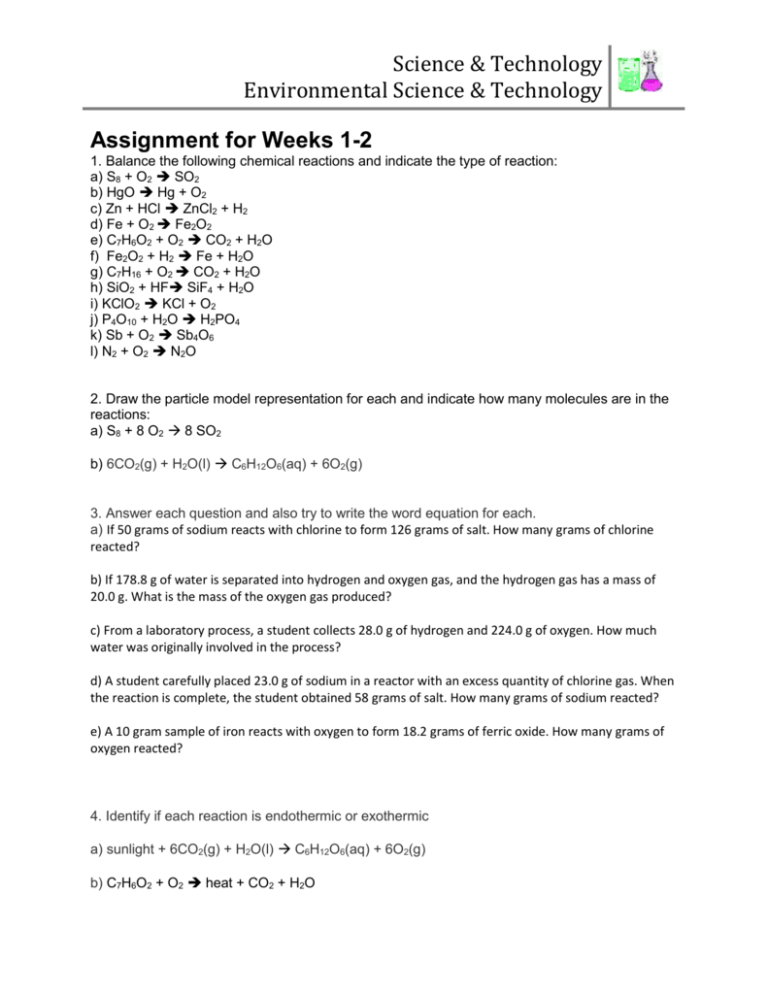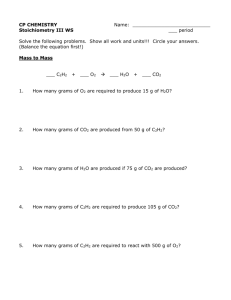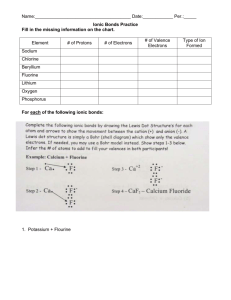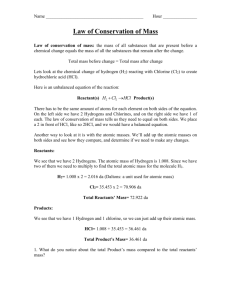File
advertisement

Science & Technology Environmental Science & Technology Assignment for Weeks 1-2 1. Balance the following chemical reactions and indicate the type of reaction: a) S8 + O2 SO2 b) HgO Hg + O2 c) Zn + HCl ZnCl2 + H2 d) Fe + O2 Fe2O2 e) C7H6O2 + O2 CO2 + H2O f) Fe2O2 + H2 Fe + H2O g) C7H16 + O2 CO2 + H2O h) SiO2 + HF SiF4 + H2O i) KClO2 KCl + O2 j) P4O10 + H2O H2PO4 k) Sb + O2 Sb4O6 l) N2 + O2 N2O 2. Draw the particle model representation for each and indicate how many molecules are in the reactions: a) S8 + 8 O2 8 SO2 b) 6CO2(g) + H2O(l) C6H12O6(aq) + 6O2(g) 3. Answer each question and also try to write the word equation for each. a) If 50 grams of sodium reacts with chlorine to form 126 grams of salt. How many grams of chlorine reacted? b) If 178.8 g of water is separated into hydrogen and oxygen gas, and the hydrogen gas has a mass of 20.0 g. What is the mass of the oxygen gas produced? c) From a laboratory process, a student collects 28.0 g of hydrogen and 224.0 g of oxygen. How much water was originally involved in the process? d) A student carefully placed 23.0 g of sodium in a reactor with an excess quantity of chlorine gas. When the reaction is complete, the student obtained 58 grams of salt. How many grams of sodium reacted? e) A 10 gram sample of iron reacts with oxygen to form 18.2 grams of ferric oxide. How many grams of oxygen reacted? 4. Identify if each reaction is endothermic or exothermic a) sunlight + 6CO2(g) + H2O(l) C6H12O6(aq) + 6O2(g) b) C7H6O2 + O2 heat + CO2 + H2O Science & Technology Environmental Science & Technology c) d) e) The following reaction takes place in a flask: Within a few minutes, the temperature of the flask drops by approximately f) 5. Identify the type of reaction illustrated. Explain. For (c) determine the ∆H. a) c) b) . Science & Technology Environmental Science & Technology Assignment for Weeks 1-2 1. Balance the following chemical reactions and indicate the type of reaction: a) S8 + 8O2 8SO2 synthesis b) 2HgO 2Hg + O2 decomposition c) Zn + 2HCl ZnCl2 + H2 single displacement d) 2Fe + O2 Fe2O2 synthesis e) 2C7H6O2 + 17O2 14CO2 + 6H2O - respiration f) Fe2O2 + 2H2 2Fe + 2H2O single displacement g) C7H16 + O2 CO2 + H2O same as “e” h) SiO2 + 4HF SiF4 + 2H2O double displacement i) KClO2 KCl + O2 decomposition j) P4O10 + 4H2O 4H2PO4 *does not work…Sorry k) 4Sb + 3O2 Sb4O6 synthesis l) 2N2 + O2 2N2O synthesis 2. Draw the particle model representation for each and indicate how many molecules are in the reactions: a) S8 + 8 O2 8 SO2 + 1 molecule 8 molecules 8 molecules b) 6CO2(g) + H2O(l) C6H12O6(aq) + 6O2(g) 6 molecules 1 molecule 1 molecule 6 molecules 3. Answer each question and also try to write the word equation for each. a) If 50 grams of sodium reacts with chlorine to form 126 grams of salt. How many grams of chlorine reacted? Sodium + chlorine 50 g sodium chloride 126 g Mass Cl = 126 g – 50 g = 76 g chlorine Science & Technology Environmental Science & Technology b) If 178.8 g of water is separated into hydrogen and oxygen gas, and the hydrogen gas has a mass of 20.0 g. What is the mass of the oxygen gas produced? Water hydrogen + oxygen 178.8 g 20.0 g Mass oxygen = 178.8 g – 20.0 g = 158.8 g c) From a laboratory process, a student collects 28.0 g of hydrogen and 224.0 g of oxygen. How much water was originally involved in the process? Water hydrogen + oxygen 28.0 g 224.0 g Mass water = 28.0 g + 224.0 g = 252.0g d) A student carefully placed 23.0 g of sodium in a reactor with an excess quantity of chlorine gas. When the reaction is complete, the student obtained 58 grams of salt. How many grams of chlorine reacted? Sodium + chlorine sodium chloride 23.0 g 58.0 g Mass of chlorine = 58.0 g – 23.0 g = 35.0 g chlorine e) A 10 gram sample of iron reacts with oxygen to form 18.2 grams of ferric oxide. How many grams of oxygen reacted? Iron + oxygen ferric oxide 10.0 g 18.2 g Mass oxygen = 18.2 g – 10.0 g = 8.2 g. 4. Identify if each reaction is endothermic or exothermic a) sunlight + 6CO2(g) + H2O(l) C6H12O6(aq) + 6O2(g) endothermic b) C7H6O2 + O2 heat + CO2 + H2O exothermic c) exothermic d) exothermic Science & Technology Environmental Science & Technology e) The following reaction takes place in a flask: Within a few minutes, the temperature of the flask drops by approximately . endothermic f) exothermic 5. Identify the type of reaction illustrated. Explain. For (c) determine the ∆H. a) b) c) a) exothermic b) endothermic c) endothermic H = Hp - Hr = 160 – 80 = +80 KJ






